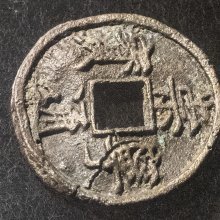Treasury: 2 definitions
Introduction:
Treasury means something in Hinduism, Sanskrit, the history of ancient India. If you want to know the exact meaning, history, etymology or English translation of this term then check out the descriptions on this page. Add your comment or reference to a book if you want to contribute to this summary article.
Images (photo gallery)
In Hinduism
Pancaratra (worship of Nārāyaṇa)
Source: archive.org: Catalogue of Pancaratra Agama TextsThe Treasury represents one of the various parts of a temple-compound (Prāsāda), as discussed in the fourteenth chapter of the Naradiyasamhita: a Pancaratra document comprising over 3000 verses in 30 chapters presenting in a narrative framework the teachings of Narada to Gautama, dealing primarily with modes of worship and festivals.—Description of the chapter [prāsādalakṣaṇa-vidhi]: [...] Nārada describes the various parts of a temple-compound—the dvāra-gates, the ardhamaṇḍapa, the mukhamaṇḍapa, the gala, the shrine for Garuḍa, placement of various other shrines in the āvaraṇa-courts, etc. He also describes the location of and appointments in the mahānasa-kitchen, where the store rooms, treasury, stable and wells are to be found, etc. [...]

Pancaratra (पाञ्चरात्र, pāñcarātra) represents a tradition of Hinduism where Narayana is revered and worshipped. Closeley related to Vaishnavism, the Pancaratra literature includes various Agamas and tantras incorporating many Vaishnava philosophies.
India history and geography
Source: Singhi Jain Series: Ratnaprabha-suri’s Kuvalayamala-katha (history)The Treasury in ancient Indian cities displayed Great jewels during celebrations of the “grand festival” (Mahotsava) of the coronation of a crown prince (yuvarāja-abhiṣeka), as depicted in the Kathās (narrative poems) such as Uddyotanasūri in his 8th-century Kuvalayamālā (a Prakrit Campū, similar to Kāvya poetry).—Page 199: Here is described yuvarāja-abhiṣeka-mahotsava when the city of Ayodhyā put on gala appearance by means of beautifying streets, [...] making offerings on the cross roads, beginning dramatic performances, hoisting of the lion banners, installing canopies, cloth pieces were being torn in proper pieces pālī for being wrapped round the post, pendants like the Kaṭisūtra ornaments were hung from the ceilings of doorways and walls of the houses, the great jewels were being taken out and put on show in the treasury [...]”.

The history of India traces the identification of countries, villages, towns and other regions of India, as well as mythology, zoology, royal dynasties, rulers, tribes, local festivities and traditions and regional languages. Ancient India enjoyed religious freedom and encourages the path of Dharma, a concept common to Buddhism, Hinduism, and Jainism.
See also (Relevant definitions)
Partial matches: Treasury, Te.
Query error!
Full-text (+541): Bhandagara, Kosha, Ganja, Bhandara, Dharmakosha, Irasalanama, Koshthagara, Potem, Potadara, Khajana, Koshagara, Dharmaganja, Bhaurika, Bhandari, Irasala, Koshagriha, Three secret treasuries, Arthasamsthana, Saptanga, Koshadhyaksha.
Relevant text
Search found 203 books and stories containing Treasury, The treasury, Valtiokonttori; (plurals include: Treasuries, The treasuries, Valtiokonttoris). You can also click to the full overview containing English textual excerpts. Below are direct links for the most relevant articles:
Shurangama Sutra (with commentary) (English) (by Hsuan Hua)
“Born Into Emptiness”: the mind organ < [Chapter 2 - Twenty-five Means to Enlightenment]
He praises himself as being equal to the Buddhas < [Chapter 3 - The Feeling Skandha]
The division in which the Sutra is included < [Chapter 1 - The Ten Doors of Discrimination]
Kathasaritsagara (cultural study) (by S. W. Chitale)
The other sections and surroundings in the Palace < [Chapter 2 - Political conditions]
Fiscal Administration and Commerce < [Chapter 2 - Political conditions]
The Chief Treasurer (Bhandagarika) < [Chapter 2 - Political conditions]
Hayanaratna: The Jewel of Annual Astrology (by Martin Gansten)
7.7. The Period of Saturn (śani-daśā) < [Chapter 7 - The Planetary Periods]
Mahabharata (English) (by Kisari Mohan Ganguli)
Section CV < [Rajadharmanusasana Parva]
Section VIII < [Rajadharmanusasana Parva]
Section CXIX < [Rajadharmanusasana Parva]
A Record of Buddhistic Kingdoms (by Fa-Hien)
Skanda Purana (by G. V. Tagare)
Chapter 46 - Abduction of Śacī < [Section 3 - Revā-khaṇḍa]
Chapter 15 - Story of a Ruler of Pāñcāladeśa < [Section 7 - Vaiśākhamāsa-māhātmya]
Chapter 319 - Greatness of Unnata Sthāna < [Section 1 - Prabhāsa-kṣetra-māhātmya]

